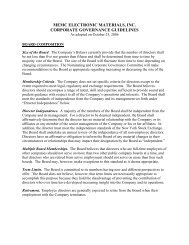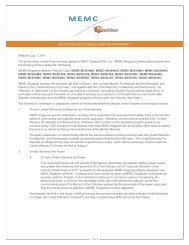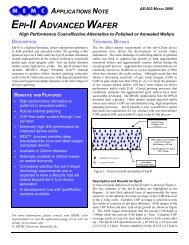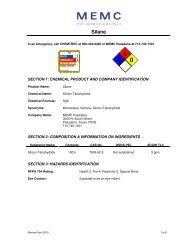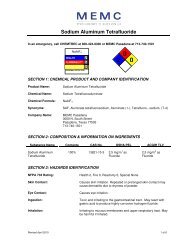AVOIDING FURNACE SLIP IN THE ERA OF SHALLOW ... - MEMC
AVOIDING FURNACE SLIP IN THE ERA OF SHALLOW ... - MEMC
AVOIDING FURNACE SLIP IN THE ERA OF SHALLOW ... - MEMC
Create successful ePaper yourself
Turn your PDF publications into a flip-book with our unique Google optimized e-Paper software.
apidly due to the extension of the sample. The graph in Fig. 8 shows that the silicon<br />
strength had been reduced to about 1/5 the original value after the dissolved oxygen<br />
concentration had been reduced from 30 ppma to 10 ppma (20 ppma precipitation).<br />
Upper Yield Stress at 800C<br />
(1E6 N/m 2 )<br />
60<br />
50<br />
40<br />
30<br />
20<br />
10<br />
0<br />
Loss of Wafer Strength<br />
0 5 10 15 20 25<br />
Oxygen Precipitation (ppma79)<br />
Fig. 8: The loss of silicon wafer strength due to oxygen precipitation is shown by these<br />
tensile test results (23, 24). The experimental conditions are described in the text.<br />
For all wafers, the main strategy for avoiding furnace slip is to heat and cool the<br />
wafers in such a way that the center-to-edge temperature difference stays small enough<br />
that thermal stress due to nonuniform expansion is always less than the critical shear<br />
stress at the current wafer temperature. When the amount of oxygen precipitation is large<br />
(like that in the wafer shown in Fig. 4), then one must either make the furnace process<br />
extra gentle or reduce the amount of oxygen precipitation to avoid furnace slip.<br />
<strong>AVOID<strong>IN</strong>G</strong> <strong>FURNACE</strong> <strong>SLIP</strong> <strong>IN</strong> WAFERS WITH <strong>SHALLOW</strong> TRENCH ISOLATION<br />
With the integration of shallow trench isolation (STI) into new IC fabrication<br />
processes, it became clear that the creation of dislocations during furnace processing had<br />
once again become a major problem (25). To produce STI structures, trenches are<br />
plasma etched into the silicon surface, the trenches are filled with CVD oxide, a<br />
densification anneal is done to fill gaps in the oxide (and to anneal out etch damage), and<br />
excess oxide is removed by CMP. Fig. 9 shows a typical cross section.<br />
Fig. 9: Sketch of STI cross section. After reference (26).<br />
Page 781



